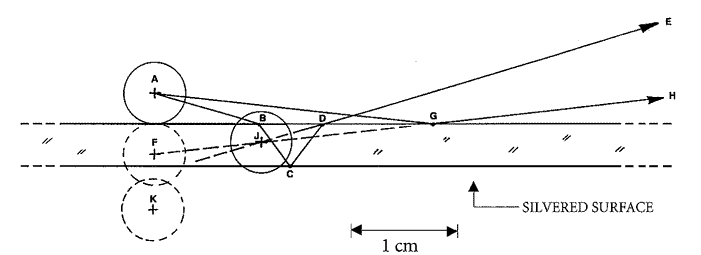|
Reprinted
from Optics and Photonics News / January 1995 / pp. 42,43:
EVERYDAY OPTICS We live surrounded by plane mirrors on walls, doors, and vending machines. We have repeatedly heard explanations of the reversed "handedness" of the mirror images we see. Yet, I have not heard any mention of a striking mirror image illusion that is easily observed in most homes. To see it, place one ear firmly against a common household mirror and look at a pencil held flat against the mirror some 30-40 cm in front of you. The pencil point and its mirror image are both clearly visible, but the mirror image appears to be 1 cm (or more) closer to you than the object itself! (Fig. 1.)
What has happened to
the conventional wisdom about plane mirror images, and even about symmetry? A full explanation brings in elements
of geometrical, physical, and perceptual optics, and may be an excellent classroom
exercise. A common door-mounted glass mirror is 5-6 mm thick. At small angles of incidence, the silver
backing has a reflectance of about 94%, and the glass itself reflects about 4.4%
at the front surface.
The direct frontal view includes the primary image of
about 86% (after the back reflection and two transmissions through the front), but
also the 4.4% surface reflection, and a series of progressively dimmer multiple reflections. When viewed from an oblique angle, the
silver reflectance stays at about 94%, but the front-surface reflectance rises with
angle in an accelerating way (that we can calculate from the Fresnel reflection coefficients
for a dielectric interface), so most of the reflection at really oblique angles is
from the front surface
of the glass -- very little of the light even reaching the silver on the back (Fig.
2).
In Figure 3, the real pencil is placed against the mirror at
A. The image at K is where the pencil will appear to be if seen in the silver back-reflection
by both eyes in a conventional (direct) view, and F is its usually dimmer reflection in the glass surface. Under the conditions of our illusion,
the path actually taken by most of the light toward the outer eye is ABCDE.
But the eye closer to the mirror receives most of its light from the pencil along
the glass-surface reflection, AGH. The two rays DE and GH,
each highly dominant at the respective eye, intersect at (and therefore both appear
to originate from) J,
so that is where your binocular vision places the apparent reflected image of the
pencil. Notice that the mirror image of the pencil amazingly seems to protrude
from the mirror surface,
a prediction easily confirmed if you touch it! A discussion of this point may enrich
the familiar distinction between real and virtual images. Acknowledgments I
wish to thank J. Bareau and M. Fulton for confirming this observation for
me, and for pointing out that when the effect is viewed by two individuals, using
one mirror and each observing the same pencil from opposite directions, the reflected
image appears to be closer to both of them. ________________________________________________________________________________ William
T. Plummer is director of optical engineering at Polaroid Corp., Cambridge, Mass. |



